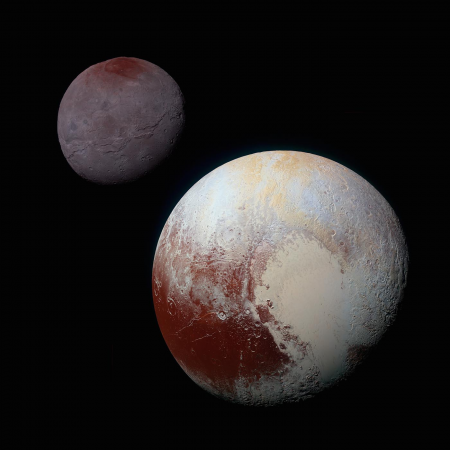November 3, 2016 – The download from New Horizons is complete. Does that mean we now know everything we can about Pluto? Not really. Just this week a re-examination of Voyager 2 data in its Grand Tour mission to the outer planets revealed two previously undiscovered moons orbiting Uranus. That’s data collected in January 1986 and it is still revealing new information about our Solar System. The moons are at the moment indirectly observed by looking at waves in Uranus’ rings. They are estimated to be between 3.2 and 14.5 kilometers (2 and 9 miles) in diameter. We have previously discovered similar moons near the rings of Uranus and Saturn and have designated such moons as shepherds because they, to some degree, keep the rings from dissipating or migrating.
The completed download of New Horizons data therefore will be studied for years and we will no doubt glean enormous amounts of knowledge about the Plutonian system as time passes. But what do we know now?
- Pluto’s predominant reddish-brown colour is likely caused by the presence of methane in the atmosphere and frozen out on the surface. This methane soot is called tholins. Mountains on Pluto are capped with methane snow.
- The heart shaped feature, named Sputnik Planitia, is 3.2 kilometers (2 miles) lower in elevation than the surrounding surface area.
- Slow convection driven by the internal warmth of the dwarf planet has created a mountain range that is the youngest yet observed in the Solar System, 100 million years old.
- Sputnik Planitia may have formed when a large object impacted Pluto.
- The mass of Sputnik Planitia is greater than the surrounding surface areas and is believed to be the reason Charon, Pluto’s largest moon, is tidally locked to the dwarf planet.
- Water ice is widespread in the crust and on the surface. Some of it floats on top of massive nitrogen ice glaciers.
- Pluto has cryovolcanoes that spew water ice and there is evidence of plate tectonics so we know that there is mechanism within the dwarf planet that works like the mantle here on Earth.
- Pluto’s atmosphere produces blue skies just like here on Earth but the clouds are largely made of methane. The atmosphere is 99% nitrogen.
- Some of Pluto’s atmosphere leaks out because of the solar wind and the evidence of the leakage is visible at the northern pole of Charon which is “spray painted” with a visible red spot on the moon’s surface.
- Charon and Pluto resemble a twin-planetary system far more than a planet and companion moon. Nix, Hydra, Styx and Kerberos, the other moons of the Plutonian system spin at high rates wobbling like tops. The wobble is believed to be caused by this twin-planet phenomenon.
- Charon’s other significant feature is an enormous canyon that stretches 1,600 kilometers (1,000 miles) in length. This crack in the surface may be caused by the upwelling of an internal water ocean that froze and expanded to the surface which appears remarkably smooth otherwise.
- The moon Hydra is completely covered by water ice.
So you are now as up to date about Pluto and its companion moons as you can possibly be. But we’ll know even more as researchers comb through the gigabytes of data that took more than 15 months to fully download.
In 2019 New Horizons will reach its next target, 2014 MU60, a Kuiper Belt object about 1.6 billion kilometers beyond Pluto. Before then instructions will have to be sent to the robotic spacecraft to clear its memory for a revised mission. Hitting the delete key brings finality to the Pluto mission and I am sure some of the scientists working with New Horizons will wonder if they got everything that the spacecraft recorded in its historic rendezvous with the dwarf planet system.












